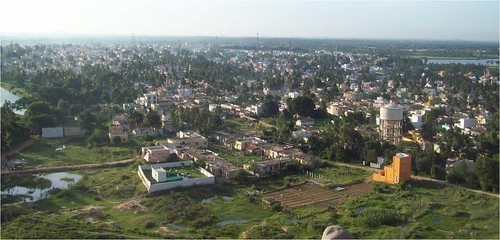Health
Influence of anthropogenic contamination on fluoride concentration in groundwater: A study of Mulbagal town, Kolar district, Karnataka
Posted on 15 Feb, 2013 04:53 PMGroundwater contamination is a serious, but relatively ignored issue in the country. This contamination occurs in either through geogenic or anthropogenic means. Fluoride contamination is one such example of geogenic contamination that is widely found in the Kolar district of Karnataka. However, the fluoride levels in the town of Mulbagal are lower than those in the surroundings. Earlier, a study was conducted on the impact of pit toilets on the groundwater in the area. The present paper investigates the presence of any link between these two phenomena.
Assessment of exposure, intake and toxicity of fluoride from groundwater sources in Unnao district of Uttar Pradesh
Posted on 28 Jan, 2013 01:40 PMFluoride is one of the most commonly found elements in the earth’s crust. It is naturally found d in water and helps in healthy tooth development and cavity prevention. However its high concentration in water can be harmful to human health. The amount of Fluoride (F) occurring naturally in groundwater is governed principally by climate, composition of the host rock, and hydrogeology. As per the World Health Organization and Indian Council of Medical Research the permissible limit to fluoride in drinking water is 1.5mg/L. Anything more than this value can cause fluorosis (dental and skeletal), which can affect the bones and teeth. In the backdrop of this aspect of water quality, this paper in RASĀYAN Journal of Chemistry, tries to assess the exposure to fluoride through drinking water consumption and to elucidate fluoride endemic areas through mapping in Unnao district of Uttar Pradesh.
Wastewater irrigation in Hubli–Dharwad, Karnataka, enables farmers to diversify their cropping practices - A paper in the Environment and Urbanisation Journal
Posted on 26 Jan, 2013 06:47 PMThis paper 'Wastewater irrigation in Hubli–Dharwad, India: I
Green Sanitation Foundation, an NGO in Kolkata develops biotoilets, a unique toilet technology
Posted on 21 Jan, 2013 12:01 PMBiotoilets are biological toilets, named so because they convert human waste into non toxic, non contaminating water compatible with environmental standards, through application of multi strain bacteria culture, using aerobic forms of bacteria.
Building a coalition for the defense and nurturance of biodiversity - Side-event by SADED at the United Nations Convention on Biological Diversity, CoP-XI, Hyderabad
Posted on 21 Jan, 2013 11:12 AMThis side event at the Convention on Biological Diversity, CoP-XI, Hyderabad on 16th October, 2012 was organized by South Asian Dialogues on Ecological Democracy (SADED) in collaboration with Collective for Self Learning on Biodiversity, Beyond Copenhagen, Center for Local Health Traditions, CECOEDECON, Harit Swaraaj, Kisan Swar
Drought mitigation measures through climate adaptation for securing agricultural livelihoods in Uttar Pradesh
Posted on 13 Jan, 2013 02:43 PMProlonged and recurrent drought, being experienced in India and various parts of south Asia, is the manifestation of climate change, partly caused by human interventions. Drought has been one of the primary reasons for widespread poverty and environmental degradation including deteriorating water quality and water security. The world has been more drought-prone during the past 25 years and the vulnerability of tropical countries to drought is likely to increase (Inter-governmental Panel on Climate Change, 2007).
Process of formation of Jajmau Area Water Partnership in Kanpur, Uttar Pradesh – Problems and solutions
Posted on 13 Jan, 2013 12:01 PMIndustrial effluents and sewage water are being diverted to the river Ganga by the cities and towns through which it passes. Nestled on the banks of Ganga, Kanpur, a highly urbanized and industrial city is polluting it most. Apart from the Government of India’s recently constituted National Ganga River Basin Authority, civil societies and NGOs too are putting rigorous efforts to make Ganga pollution free. Though the city has several big and small industries, the leather industries located in Jajmau, the oldest part of the city add to the problem of pollution in the river to a large extent.
Effect of drinking arsenic-contaminated water in children- Article in Indian Journal of Public Health
Posted on 09 Jan, 2013 10:44 PMThis paper in Indian Journal of Public Health sheds light on the specific impact of arsenic on health of children based on the review of literature on the subject. The effects of chronic arsenic toxicity under the following aspects:
- Psychological
- Skin abnormalities
- Lung diseases
- Defect in intellectual function
- Genetic issues
Punjab chief minister objects to draft national water policy - Roundup of the week's news (December 31 – January 6, 2013)
Posted on 08 Jan, 2013 08:03 AMObjection raised to National water Policy





